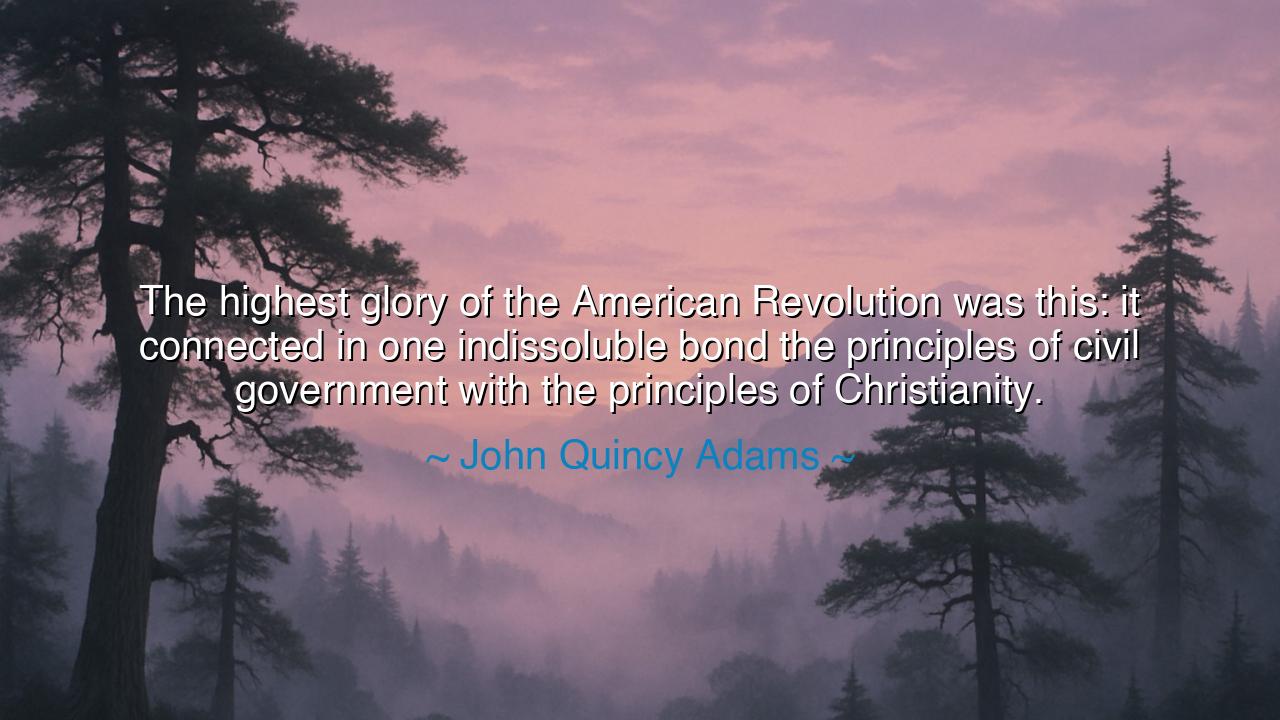
The highest glory of the American Revolution was this: it
The highest glory of the American Revolution was this: it connected in one indissoluble bond the principles of civil government with the principles of Christianity.






"The highest glory of the American Revolution was this: it connected in one indissoluble bond the principles of civil government with the principles of Christianity." Thus spoke John Quincy Adams, son of liberty’s architect and heir to the moral vision of the founders. In these words, he sought not merely to honor the triumph of arms, but to illuminate the spiritual foundation upon which the American Republic was built. For the Revolution, in Adams’s eyes, was not a rebellion of mere politics, but a covenant — a marriage between the temporal and the eternal, between civil government and Christian virtue, forged in the fires of conscience and consecrated in the belief that freedom without morality is chaos, and morality without freedom is bondage.
Adams was a scholar, a diplomat, and a man of deep faith. Born amid the birth of a nation, he had witnessed both its struggle for independence and its struggle for identity. He knew that revolutions often devour their own children, collapsing into tyranny when unmoored from moral principle. France had risen in passion but drowned in blood; other nations had cast off kings only to find new masters. But America, he declared, had found a higher path. Its “highest glory” was not in victory over Britain, nor in the creation of new institutions, but in the union of freedom and faith — the belief that true liberty could only endure when guided by virtue, and that virtue itself was sustained by the moral teachings of Christianity.
To understand Adams’s meaning, we must remember the world from which America arose. The Old World was ruled by thrones and cathedrals intertwined in uneasy alliance, where church and state often corrupted one another — kings who invoked God to justify oppression, and clerics who bowed to power for favor. The founders of the new republic sought a different harmony: a government without tyranny and a faith without compulsion. They did not seek to establish a theocracy, but to ground freedom in the moral law that Christianity proclaimed — the dignity of the individual, the equality of all souls before God, the duty to treat one’s neighbor with justice and compassion. This was the “indissoluble bond” of which Adams spoke: a bond not written in law, but woven into the conscience of the people.
This connection between faith and freedom was not an ornament of the Revolution — it was its heartbeat. When the Continental Congress opened its sessions with prayer, when the Declaration of Independence appealed to “the Laws of Nature and of Nature’s God,” they proclaimed a vision of governance that recognized both divine order and human agency. To govern justly, they believed, was to reflect the moral order of Heaven in the affairs of men. The civil government was to secure rights not as gifts of the state, but as endowments from the Creator. Thus, the Revolution did not create freedom out of nothing; it revealed freedom as a sacred inheritance, bestowed by God and defended by conscience.
History has proven the wisdom — and the peril — of Adams’s words. When the American people have remained faithful to this bond, the nation has flourished. It was the moral conviction born of Christian principles that fueled the abolitionist movement, that inspired reformers to fight for justice, that sustained communities through hardship. But when the people have turned away from moral restraint, seeking liberty without responsibility, the union has trembled. The corruption of politics, the decay of virtue, the worship of self — these are signs not of liberty fulfilled, but of liberty forgotten. As Adams warned, freedom without the guidance of faith becomes a weapon against itself.
Yet Adams’s message is not one of gloom, but of hope and duty. He calls each generation to renew the sacred harmony between moral principle and civic life. He does not ask that government preach religion, but that citizens live by the moral truth that undergirds their freedom. The state may protect rights, but it is the people who must protect virtue — through honesty, compassion, humility, and service. A nation can only be as just as its citizens, and citizens are only as just as the truths they hold sacred. The Revolution’s glory endures not in monuments or armies, but in hearts that still believe that freedom is a trust, not an entitlement.
The lesson of John Quincy Adams is thus timeless: liberty and morality must walk together, or not at all. To separate them is to destroy both — for without virtue, freedom collapses into anarchy, and without freedom, virtue loses its breath. Let each person, then, cultivate the Christian principles that ennoble life: love of neighbor, honesty in word and deed, humility before truth, and faith in the higher purpose of human destiny. Let these principles guide our politics, our work, and our daily choices.
So remember the wisdom of John Quincy Adams, the son of the Revolution and guardian of its soul: the true glory of America lies not merely in its Constitution, but in the moral light that sustains it. The Revolution’s victory endures only so long as its people live as free souls under God — bound not by coercion, but by conscience; not by force, but by faith. For when civil government and divine principle stand together, neither can be shaken — and the flame of liberty burns with an eternal and holy fire.






AAdministratorAdministrator
Welcome, honored guests. Please leave a comment, we will respond soon